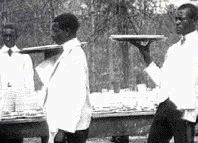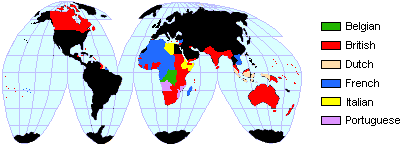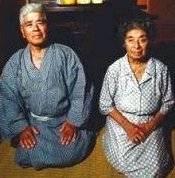In the 19th and early 20th
centuries, the European American dominated political system in the U.S. restricted legal
rights of people they defined as being African, Asian, or Native American in
ancestry. Their property and voting rights were limited and they were treated as 3rd
class citizens. Similarly, in Japan today, tens of
thousands of 2nd and 3rd generation resident Koreans
who have adopted the Japanese language and culture
are given only limited rights if they retain their Korean
citizenship. They are not allowed to be
fully Japanese because dual citizenship is not permitted. This
leaves them in a marginal status and limits their job prospects.
| |
 |
|
Early 20th century
photo of
African American servants |
|
People in political
and economic power
usually define their own ethnic/racial group as being superior and others as being
inferior. This can be done by laws that restrict rights and privileges. It
also can be done in subtle pervasive ways even when ethnic favoritism is officially
illegal. For example, throughout much of the 20th century in America, "white"
became identified in popular literature, films, and the mass media with intelligent,
good, pretty, and successful, while "black" was identified with the opposite.
The early 20th century photo (on the right) of
African Americans depicted as an underclass
of servants satisfied the common European American perception.
African Americans are not
unique in having a relentless negative image of themselves portrayed in the popular
media. Mexican Americans, Arab Americans, and some Southeast Asian groups are also
experiencing it to some degree. In fact, most minority groups in heterogeneous
societies like the United States have had a similar experience. Even European
immigrants, such as the Irish in the 19th century, were commonly portrayed in the press as
being dirty, stupid, alcoholic, and violent. Before the Civil War
in the southern states, Irish immigrants
were hired for construction jobs that were considered too risky for
black slaves because they were monetarily valuable, unlike the Irish. Even
as late as
the mid 20th century, unemployed Irishmen in the
Northeastern U.S. were at times faced by signs saying "No
Irishmen need apply."
Hollywood's strongly
negative portrayal of specific ethnic groups continues. However, the targets have
changed. Today, Moslem Arabs, Iranians, and Afghans are consistently cast as irrational
terrorists and villains in action films. They have been impersonalized and
stereotyped on-screen with derogatory slurs such as "rag heads." They have
mostly replaced Germans, Japanese, American Indians, African Americans, Eastern
Europeans, Chinese, and Communists
from any nation as the most dangerous "bad guys."
Whether you have a negative
or a positive self-image stemming from your ethnicity/race, gender, or physical condition
generally has a powerful effect on the way you relate to others and lead your own
life. For instance, a belief that you are not likely to succeed in education,
because "members of your group are inherently less intelligent," can lead to a
self-fulfilling prophecy. Why try to succeed in
school if you think that you will fail? Likewise, a strong belief that most members of another
group actively discriminate against your group is likely to lead you to be distrusting of
the others and to even seek revenge against them.
In
North American middle class "white" families today, it is not uncommon for
teenagers to feel a lack of ethnic identity. There is a perception that
they are not anything. This should not be a surprise since their
education has generally emphasized the value of ethnicity for others but not
them. The use of terms such as "people of color" for African, Asian, and
Native Americans in a sense stigmatizes European Americans as "people without
color"--a negative classification. This along with revised American
history that emphasizes the unfairness of "whites" in their interactions with
others leads many European American youths to have a somewhat negative image
of their ethnicity and of themselves. Subsequently, they become eager
vessels to accept the ethnic traits of others. This may be one of the reasons that
they have readily adopted the music, style of dress, and
slang of Black America. Likewise, tacos, burritos, and other Mexican
foods have become as popular as hamburgers for teenagers and young adults,
especially in the Southwest.
Creation of
New Ethnic Groups
During the 19th century, new
ethnic groups were created by European colonial governments in order to facilitate
ruling their new indigenous subjects. This was the case in Australia and over much
of Western North America where there had been small, independent bands of foraging
societies. The bands were combined into larger political units by government
officials in order to simplify the control of them. Indigenous leadership positions, such
as chiefs, were created for peoples who previously did not have the concept of a leader
who could act and speak for their societies.
| |
 |
|
European colonial empires in 1938
|
Similarly,
the colonial powers forced diverse ethnic groups to see themselves as being part of larger
nations with common ethnicity. This was the case in India, Malaysia, New Guinea,
Indonesia, the Philippines, and much of Africa. In part, these new nations were
created to facilitate control.
Some ethnic groups have been
created by themselves for the rational goal of gaining political and economic power.
It has been suggested that this was the case with
Latinos
in the United States. Until the 1960's, their identity was mostly as distinct Mexican
American, Cuban American, and Puerto Rican groups. Since then, a feeling of shared
cultural identity as "Hispanics" has been fostered by Latino leaders. At
the same time, the significant cultural differences between these groups have been
underplayed in order to reinforce Latino unity.
As new Central and South American
immigrants arrived, the Latino ethnic group redefined itself to incorporate them
as well. Even Portuguese speaking Brazilians have been included. The creation and recognition of a homogenous Hispanic identity was fostered
by the national government. The term "Hispanic" was actually created
by federal bureaucrats working under President Nixon in the early 1970's.
Summary
We have seen that ethnic
identity is often complex. It can change dynamically through time as situations
alter. It can be created by self definition or others can define it for us whether
we wish them to or not. The power to label others is the power to control
them. Our stereotypes of groups has a strong effect on how we view and relate to
members of those groups. It also can have a profound effect on how we see
ourselves. Definitions of ethnicity and "race" have immense political
importance in America today. Those ethnic groups that have a high public visibility
generally have political clout. Those that are largely invisible do not.


